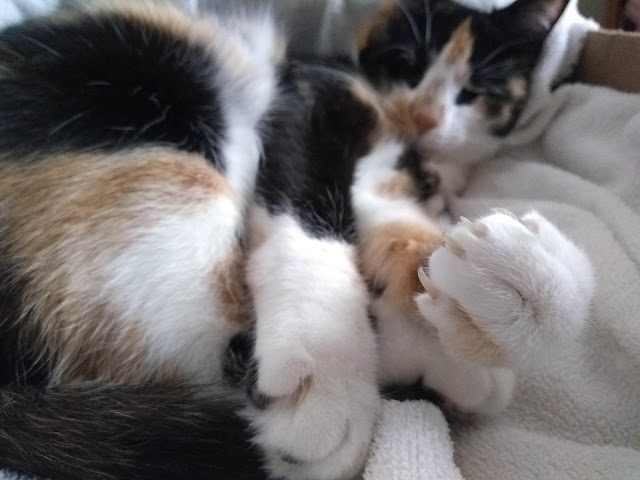Tonks was pretty sure you needed to see her adorable toesies again this week, so here you go!
Tip of the Day
Yesterday, we gave a lengthy tip on administering oral medications to your kitty. Today, we're here to give a lengthy tip on the ins and outs of transdermal medications. Transdermal medications are those applied to and absorbed through the skin. A number of medications can be given this way, such as methimazole (for the treatment of hyperthyroidism) and even famotidine (Pepcid), just to name a couple. If you will be administering transdermal medication for your kitty, of course read the directions as prescribed by your veterinarian, and discuss with your veterinarian any concerns that you have.
So, transdermal medication has to be applied to, obviously, the skin. It is best applied to skin that is clean, free from as much as hair as possible, and where your kitty cannot easily lick or reach. This makes the pinna (the flap of the ear) an ideal place for applying transdermal medication.
To actually apply the transdermal medication, ensure that you are wearing gloves. As its name suggests, this type of medication does indeed absorb through the skin, and that includes your own skin as well as that of your kitty. If your kitty is on transdermal thyroid medication, for example, using your bare hand to apply it could lead to unwanted effects on your own endocrine system. So, put on disposable gloves, which are sometimes even provided with the prescription.
Next, when you and your kitty are ready and your hand is gloved, place the medication on your gloved finger. Transdermal medication is typically provided in pre-filled syringes, from which you can eject intended dosages. Sometimes it is suggested that you squirt the medication onto your index finger, but, ultimately, place it on whichever digit works best for you and for effective administration. I, personally, find it easiest to use my thumb.
Now, when you have the medication on your gloved finger, apply it to the upper to middle part of the pinna of the ear and rub it in. Again, this medication is easily absorbed through the skin, and so excess being left behind is not ideal. So, rub it in as thoroughly as possible, which of course will also ensure that your kitty is receiving his or her full dosage.
Once you have rubbed the medication in, you can dispose of your glove. For optimum safety, you can clean it off first, such as with soap and water. Then, you can remove it using the aid of a paper towel. Then, the glove and paper towel can be disposed of, of course in a receptacle where it cannot be easily removed by any curious paws or hands. Also be sure that you put away the syringes of medication away somewhere.
All of that being said, of course try to make the medication administration process as comfortable as possible for both your kitty and yourself. You can try to do apply transdermal medications when your kitty is relaxed, as long as you are prepared and are able to safely do so without getting any of the medication on yourself or anywhere else besides your kitty's ear. You can also, of course, use treats as a reward. Just as with oral medication administration, you can use a partner-in-crime if needed, or a blanket or towel to help keep your kitty still and safe. Sometimes it takes trial and error to figure out what works best for you and your kitty, and there's nothing wrong with that.




4 comments:
The veterinary world needs to do more research on cat medications, because they have completely different ways of metabolizing than humans or dogs.
Tonks has the cutest toesies. Cute drawing and excellent tips. Transdermal meds are so good for cats hard to medicate. XO
Lovely toes, including the nicely sheathed sabers.
They're super duper cute!
Post a Comment